Two fine wines from Rheinhessen: freshness over power
November 30, 2011
It was 11 November 2011, 11-11-11. What is called Remembrance Day, or Poppy Day or Armistice Day, is a memorial day observed in many countries since the end of World War I, to remember the members of their armed forces who have died in the line of battle. It is an official holiday in France and in the United Kingdom, but not in Germany. After all, Germany lost World War I.
So all the better for me to have rented a car during a bank holiday in France – I even got an upgrade to a Mercedes E-Class – and visit two top German vineyards in Rheinhessen, about a two hour drive from Strasbourg.
What a lovely visit to Flörsheim-Dalsheim. A charming medieval village, with much of the original Fleckenmauer – the village wall, built between 1470 and 1490 – almost entirely in tact. Klaus Peter Keller drove me to the wall and then to some of his vineyards. We got to talking about wine, and how I started really getting the fever with Bordeaux. He explained to me that he likes older Bordeaux, that have greater freshness. “Then again, I like acidity,” he said. He enjoys lemon and grapefruit in the morning… and seeks freshness in wine. Certainly acidity plays a key role in German wines.
He is also a friend of Frederic Mugnier of Chambolle Musigny, and they exchange bottles. Like Mugnier, he prefers 2008 to 2009. For Keller, 2009 is a “journalist vintage” whereas 2008 is more serious. He says that a wine will last as long as the time it took its grapes to ripen. Because ripening was longer in 2008, the wines will last longer.
In 2009, the ripening came easily. He even compared a vintage like 2009 to a child that gets everything he wants. He conjured up an image of an easy, almost spoiled childhood. 2008 resembles more a child brought up in Harlem, who fights hard to succeed and – as a result – has more character. How this metaphor validates his opinion about the two vintages I leave up to you to ponder, but it would be indeed very interesting to buy several bottles of both 2008 and 2009 – and compare in the years to come. As in Burgundy – see HERE the notes from my last visit to Burgundy, including from Mugnier – I wonder if the winemaker has gone “too native” and misses the forest for the trees. Let’s face it: as THIS TASTING indicated, there were some fabulous 2009s from Germany… including Keller’s wines. But I am not about to presume against the wise counsel of someone as gifted as Mr. Keller. For his wines are superb. Still, the blogosphere is full of discussion regarding the merits of 2009 vs those of 2008: see HERE, HERE and HERE.
The Keller family has owned its domain since 1789, although there have been changes over time. They currently own 15 hectares, including a just recently purchased plot of vines in Nierstein. Klaus-Peter (photo at left) dislikes marketing or promotional trips. He is almost always at the Weingut and has one full-time employee, no consultants. He does not believe in dividing labor between vineyard and vat room, like other estates do. When I asked him who is his viticulture manager and who is his cellar master, he offered a quizzical look: “Both are fundamentally related; one must be familiar with both to make the wine completely,” he explained. What makes his wines so special? A distinct freshness of course, but also superb concentration – and constitution.
The 2010 vintage was a challenge, and he likes challenges, he said 2010 was saved by a lovely late autumn, before which vintners had much to be nervous about, Keller said. “We had real fear for the vintage,” he stressed. “But the slow ripening resulted in better ripening.” Winter was long and snow-filled and the vegetation cycle at first delayed. But June and July were so particularly hot, that a cool August was welcome, to lend vines needed freshness. Lower than expected yields were expected given a problematic flowering.
Keller also remarked that global warming trends were marked more by extreme weather changes: sometimes one must fight for ripeness (2010), sometimes almost too ripe (2009). He told me about David Rayer, a wine critic who will soon move to Strasbourg – and we agreed to organizing a dinner together. I must say that the wines I tasted from 2010 at Keller were uniformly at least good, and one particularly impressed me… alas that one wine is extremely difficult to find because so little is made. Bottom line, Keller’s outlook reinforces my feeling about the important of freshness over power in wine, whether red or white.
Tasting notes: all 2010s (wines in bold, I like; in red and bold, even more; when underlined, the most)
Riesling Von der Fels: Coming from 15-30 year old vines in grand cru vineyards, but too young for the grand cru bottling, this wine exhibited fine stony aromas and a rich even succulent palate. I wrote “lovely” rather spontaneously. The flinty aspect on the nose, and a lime like fresh finish seduce the taster. 12% alcohol. Not much residual sugar, or so it seemed to me.
Kirschspiel GG: A 3-hectare vineyard planted in 1964, some vines planted also in 1986, with red soils and limestone. He calls this wine the “prima ballerina” because it is more feminine. Some two grams of residual sugar. What I liked about this was a refined elegance that matched, again, an opulent palate. But it seemed a touch closed when compared to the Von der Fels, albeit more complex.
Hubacker GG: The best plots from this vineyard belonged already to the Keller family at the end of the 18th century, and Klaus-Peter considers this a more masculine wine when compared to the Kirschspiel. Here we have limestone under clay soils. The wine seems more like a red wine, with spicy red fruit and red apple aspects, some herbal notes. At 12.5 alcohol, full bodied. Would go with veal, we both agreed.
Pettenthal GG: Now this was my hands down favorite of the tasting. Coming from a vineyard purchased in Nierstein in 2010, with slate soils (60%), this wine was at once elegant and silky, with much body. Upon leaving the estate, Klaus Peter kindly gave me the open bottle which I then shared with fellow blogger Jürgen Steinke, who said it was indeed fantastic. A bit of history: vines from this vineyard were used to make wine that was served on the Titanic, and it cost more than the 1st growths of Bordeaux. A revelation wine, but only one importer in the US and sold sparingly. Do you want a score? 97 or so would do it. Maybe more?
Not far from Keller, another famous Rheinhessen domain, established in 1663. A beautiful estate, with some 30 hectares of vines. Philip Wittmann is the director, and I had met him earlier this year in Bordeaux for a tasting, but he was not at the property on the day of my visit. Instead I was met by Georg Rieser, assistant to the cellarmaster, and Karin Schirb, who hosts tastings for the domain.
At first Georg showed me around the vat room, including large old oak casks with fermenting wine. Then we went into a larger vat room. The grapes are hand picked. Stainless steel and oak fermentation. Since 1998, biodynamic winemaking. Georg had worked with the Didier Dagenau in the Loire Valley. Domain Wittmann is a well organised and beautiful property.
Careful pressing to preserve elegance, Georg said.
Tasting notes / most all 2010s (wines in bold, I like; in red and bold, even more; when underlined, the most)
Silvaner Trocken: Nice iodine like aspect, limestone terroir, not plump (as opposed to the 2009, which was a bit too fat, Karen said). A pretty wine, if a tad fat on the finish… 12.5 alcohol
Westhofener Silvaner Trocken: A lieu dit this time, coming from older (50-years-old) vines, and the stony nose was matched by a rather creamy palate. Refined. A very fine Silvaner, so much so that I bought three bottles. 13 alcohol.
Weisser Burgunder Trocken “S”. This is Chardonnay made with some new oak. Had a Chablis aspect, green apple, and yet also a tad warm on the finish. Overall impression: disjointed. There is balancing acidity, but I noticed the components rather than their cohesion.
Riesling Trocken: Made from younger vines from various vineyards, the nose is subtle if a bit closed, and the palate displays a bit of damp rock and spice. There is a white pepper aspect, too, its 6.9 grams of residual sugar backed by just as much acidity. Nicely done! I bought a six pack.
Aulerde Riesling Grand Cru Trocken: More feminine here, coming from limestone and clay underneath, from the 5 hectare vineyard, showing peach, iodine and softness overall.
Kirschspiel Grand Cru Trocken: A grand cru. This is more subtle, coming from a 3 hectare vineyard, subtle floral notes, with a more substantial palate and a longer finish, pear like. The acidity is very present now, but this will be lovely in a few years. 6 grams of residual sugar to balance the almost searing acidity…
Brunnenhäuschen Grand Cru Trocken. Their smallest grand cru vineyard, not even one hectare and not officially on the price list. Well, very lovely, with an almost tobacco aroma and flavor along with stone and mineral.
Morstein Grand Cru Trocken. Just 3 hectares. White limestone. Pure mineral aspect, not fat, powerful but elegant. Herbal aspects, too with smokiness, very subtle. This is a wine to seek out, perhaps more balanced than the 2007, although the 2007 is wonderful today.
Morstein Grand Cru Trocken 2007: This is a wine I had tasted before, in Bordeaux in June. A balance of 8.4 grams of residual sugar and 7.5 grams of acidity per litre. At the domain, once again very complete and succulent… I thought of a pumpkin soup to go with it. I managed to buy a few bottles in Berlin, and brought one with me to a Chateau Palmer dinner I had organised later in November (notes coming!) I said one could compare it with the famous Clos St Hune Riesling from Trimbach, but Chateau Palmer development director Bernard de Laage de Meux said that it is not as good as Clos St Hune. Perhaps not as precise? I think it could rival certainly the Cuvee Frederic Emile… Whatever the case may be, this is top notch German Riesling!
Well, folks, this journey is still going on, but many thanks to my wine pals in Washington D.C. and in Germany for turning me on to fine German wine. Stay tuned for more wines, more tasting notes…


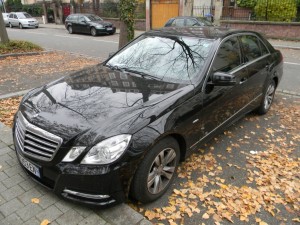


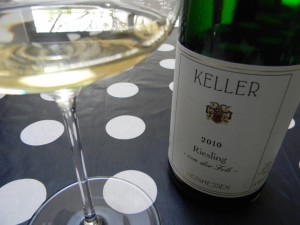
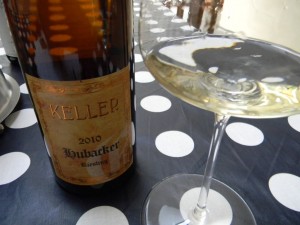
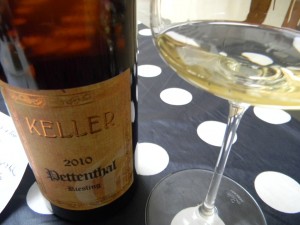
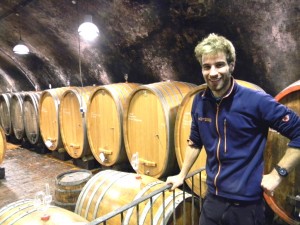
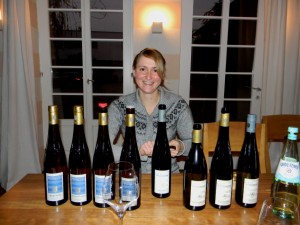
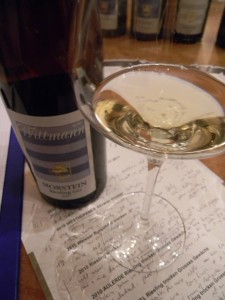
[…] next three years. His vines border those of Keller who had recently purchased vines there as well, as you can read from my notes when I visited Klaus Peter. Perfumed floral aromas and a precise albeit tension ridden palate. Acidity is very high in 2010, […]
What’s up, I read your blogs on a regular basis. Your writing style is witty, keep doing what you’re doing!|